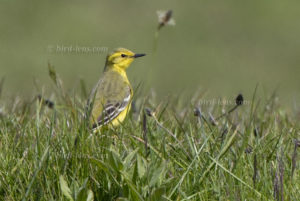 Although the distribution area of Motacilla flava flavissima is not far from Germany, records of this (sub-)species are quite rare. As to be expected, there are some records from the islands in the wadden sea (Amrum, Sylt-Ost, Norderney, Wangerooge, Neuwerk, Baltrum) or near the coast as e.g. Horumersiel but the best location for a german twitcher is Heligoland for sure. Thus, we were alerted when we saw a record in Ornitho.de at the end of May 2019.
Although the distribution area of Motacilla flava flavissima is not far from Germany, records of this (sub-)species are quite rare. As to be expected, there are some records from the islands in the wadden sea (Amrum, Sylt-Ost, Norderney, Wangerooge, Neuwerk, Baltrum) or near the coast as e.g. Horumersiel but the best location for a german twitcher is Heligoland for sure. Thus, we were alerted when we saw a record in Ornitho.de at the end of May 2019.
Something yellow flashes in the green grass. Could this be the Yellow-headed Wagtail (Motacilla flava flavissima) reported this morning? On the circular route over the upper plateau of the tiny off-shore island Heligoland we actually pass a cow pasture. 6 Galloways and a goat can be seen on a pasture fenced with electric wire. Here at the so-called Oberland of Heligoland the Yellow Wagtail of the subspecies flavissima was spotted this morning. That was at 10:15 am, much earlier than now at 4:00 pm. But the cattle meadow seems to be still worth a look. Not least because of a pale upright passerine bird on the short-grass pasture. I think of a Tawny Pipit (Anthus campestris). But the view through the binoculars shows a female Northern Wheatear (Oenanthe oenanthe). Didn’t I hear the call of a wagtail? Well, that could be from the White Wagtail (Motacilla alba), which comes flown in shortly before the electric fence. But then I see something yellow flying in. Yes, this is definitely a Yellow Wagtail (Motacilla flava). Immediately I give 2 shots with the camera and decide to walk closer to the fence. There is a beaten track. The wagtail is briefly gone, but then it comes out again behind a hilltop. It is indeed the British Yellow Wagtail. And that a good 6 hours after its first discovery. As we get closer, the English or British Yellow Wagtail – which is the subspecies of the British Isles has suddenly disappeared. We suspect it in an old bomb funnel. We sit down at the fence and build on the fact that the Galloways will chase them out of the funnel again sometime. Or one of the Common Oystercatchers (Haematopus ostralegus) will do that for us. After about 15 minutes we have to admit to ourselves that the British Yellow Wagtail has probably gone away. We walk further along the trail. A little later it stands in the eastern part of the pasture. There it also changes its position and is seen together with the two Northern Wheatears one last time in the middle part of the cow pasture.
After some rainfalls this last May day was very pleasant on Heligoland. Accordingly, many visitors were on their way to observe the many seabirds at close range at their nesting sites. The bird cliffs of Heligoland are for years one of the most popular destinations for ornithologists and other nature enthusiasts from all over the world. Especially since the red cliffs are home to Common Murre (Uria aalge), Kittiwake (Rissa tridactyla), Razorbills (Alca torda) and Northern Fulmar (Fulmarus glacialis) as well as the highly photogenic Gannets (Morus bassanus). More and more bird enthusiasts are drawn to Germany’s only off-shore island. As you can see from the small episode about the British Yellow Wagtail, it is also worth taking a look at the other, inner side of the island if you visit the bird cliffs.
Bird-lens is above all a website that is supposed to satisfy the growing demand for top shots of the birds of the Western Palearctic. In order to satisfy the growing demand for top photos of rare bird species, Bird-Lens.com has also made targeted trips to distant places such as Alaska and South America. All this to be able to provide excellent photos of birds. The yield of pictures not only of rare Western Palearctic birds is very good.
The picture of the blog is only a first impression, what you will find in behind the tab “Picture Shop” very soon. Just let bird-lens.com know if you need a picture of a bird species before new pictures are online.